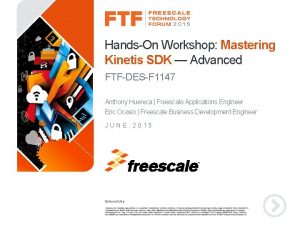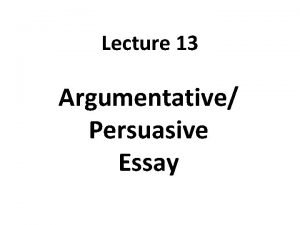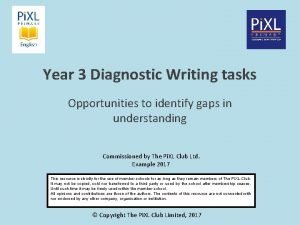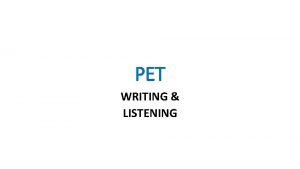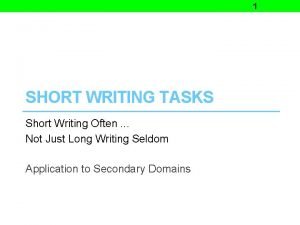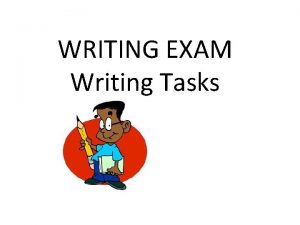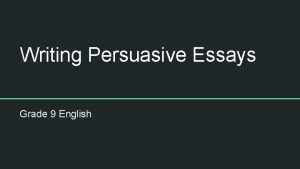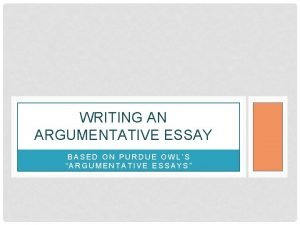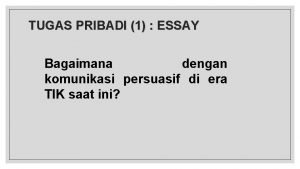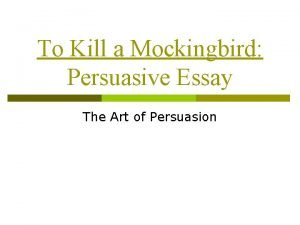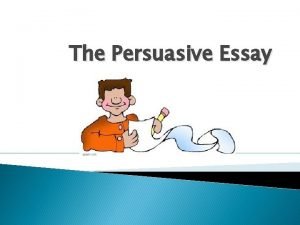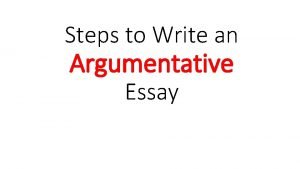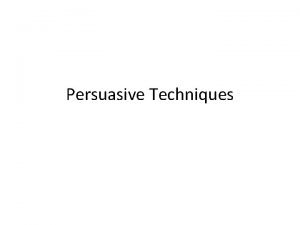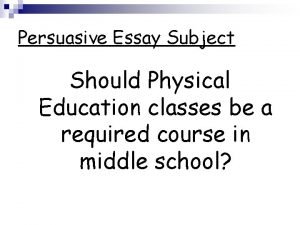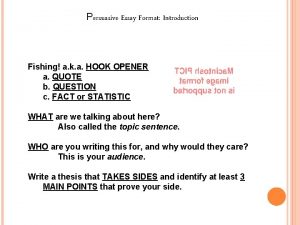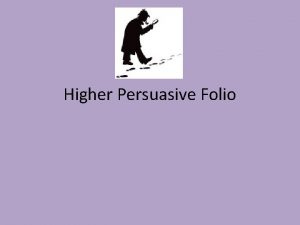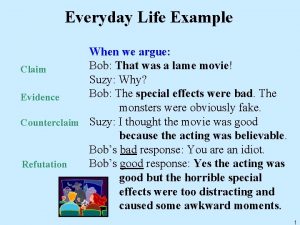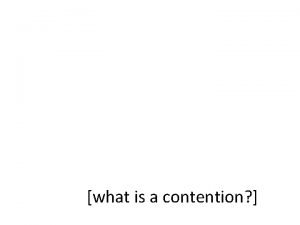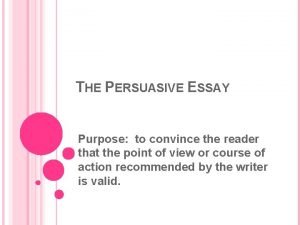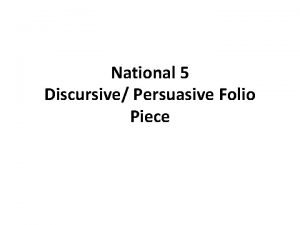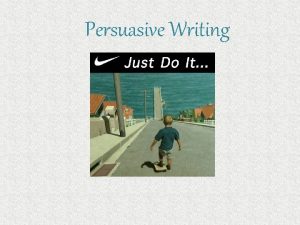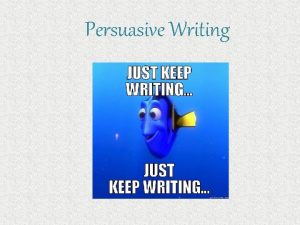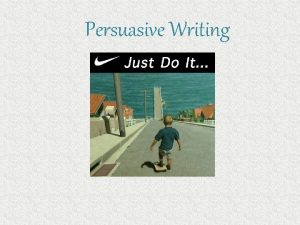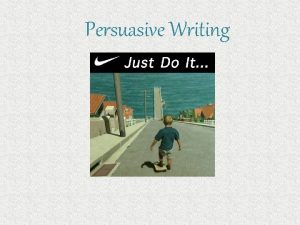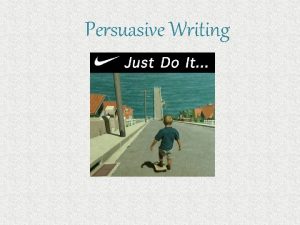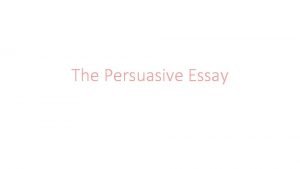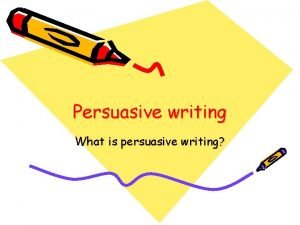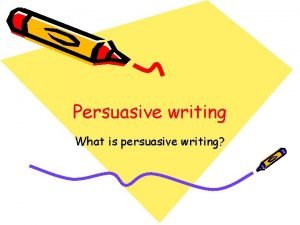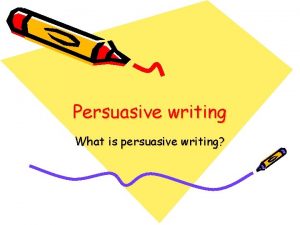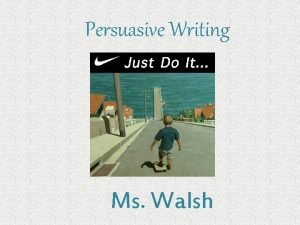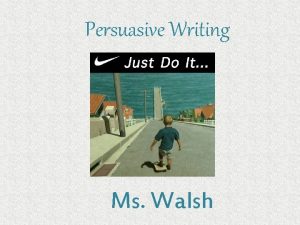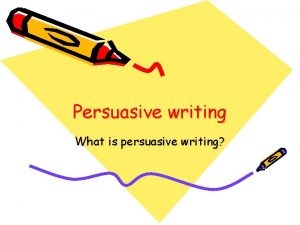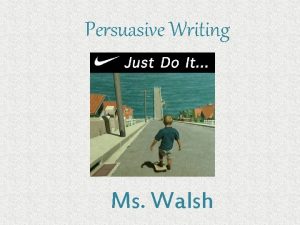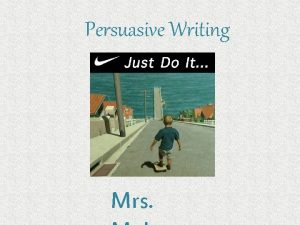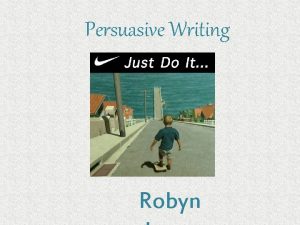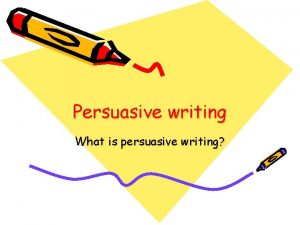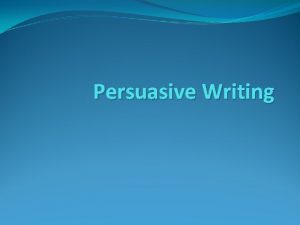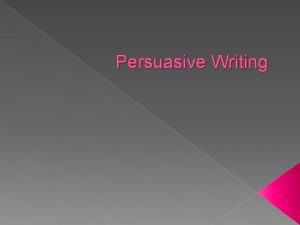Persuasive Writing Tasks 1 Evaluation of Last Essay

























- Slides: 25

Persuasive Writing Tasks: 1. Evaluation of Last Essay 2. Identify Persuasive Writing tactics 3. Active Reading to Analyze Sources Tuesday 1. Paper Structure and Organization

Steps in Writing a Persuasive Essay 1. 2. 3. 4. Gather information and analyze sources Brainstorm Argument for each side of the issue Pick a side and write a thesis Find specific supporting evidence from your sources 5. Organize your essay 6. Write!

Identifying Persuasive Writing… What types of information is useful for creating Persuasive Arguments?

What Elements Must an Argument have to be Persuasive? What arguments do you find more persuasive? And Why? Argument A • Our family should go to Disneyworld for vacation because I want to go someplace warm. Argument B • Disneyworld would be an excellent choice for a family vacation because Florida is considerably warmer than Connecticut during the winter months. Florida has a tropical climate that is traditionally between 50 - 70 °F in February.

What Elements Must an Argument have to be Persuasive? What arguments do you find more persuasive? And Why? Argument A • The lunch room should serve pizza because Mrs. Da. Vinci, the cafeteria manager, says “the whole wheat pizza that we serve is both healthy and extremely popular with the students, ” (Source #1). Argument B • The lunch room should serve salad because it tasty and good for you.

Persuasive Tactics Facts vs. Opinions Statements vs. Arguments • Facts based on data or • Statements are experts in the field unsupported claims Vs. vs. • Opinions based on your own • Arguments form conclusions preferences or beliefs based on reasoned judgments or facts.

Interdisciplinary Writing Assignment Egypt vs. Persia Which Empire, Egypt or Persia, would have been better to live in? Assignment: The purpose of this Interdisciplinary Writing test is to determine how well you can write to persuade others to think as you do about an issue. In this test, you will read several short articles about an important issue, take a position on the issue and write a draft of a persuasive essay. You must support your position with information from BOTH of the Two sources. Requirements: 1. Choose a position 2. Use a persuasive essay format 3. Must use at least 3 of the assigned sources

Persuasive Essay Arguments and Supporting Details Your Task for a Persuasive Essay Today’s focus • Take a Position • Create Arguments Sources: • How to read primary and secondary sources with purpose in order to extract arguments and supporting details. – Where in your paper’s structure do you first state your position and your arguments? • Use Supporting Details (specific examples) to prove your arguments

Reading Comprehension Skills How to be an Active Reader Steps to Active Reading 1. Gain an overview of the text before reading – Make predictions about what you are about to read based on title, author, and any introductory information – What do you think your reading is going to be about? 2. Read with Purpose – Find the Main Idea (highlight or underline) – Read the Questions before you read the text 3. Understand the Vocabulary – Highlight any vocab words that you are unsure of – Look up or ask for a definition, or use context clues to decode the vocab word 4. Connect what you are reading to background knowledge or personal experience – Associate ideas in the text to what you already know • • What does your reading remind you of? What units or topics have you covered in history class that relate to what you have read? – Note whether your predictions and expectations about the text are correct. Keep Track of your Reading 5. Be Active while Reading • Keep a record of your thoughts as you read – Highlight main points – Write in the margins of the text any connection you can make – Write any questions that you have about your reading – Write questions that the reading generates for you on other topics • These notes can be a reminder for you later on

Document #1 Reading: The Society of the Persian Empire Home Decor • The furniture used by the wealthy classes was very costly. The tables were plated or inlaid with silver and gold. Splendid couches, spread with gorgeous coverlets, invited people to rest and relax. In order to better insure their comfort, the legs of the couches were made to rest upon carpets, which were sufficiently elastic to act as a sort of spring, rendering the couches softer and more luxurious than they would otherwise have been. Gold and silver plate, especially in the shape of drinking-cups, was largely displayed in all the wealthy mansions, each household priding itself on the show which it could make of the precious metals. Active Reading Activity 1. Gain an overview of the text – Make a prediction 2. Read with Purpose – What do you want to know about this excerpt? 3. Understand Vocabulary 4. Make connections while reading – What does the reading remind you of? (past topics/ personal experiences) 5. Be Active while reading: – – Highlight important pts. Come up with at least 1 question that this excerpt makes you think about.

Document #1 Reading: Active Reading Activity The Society of the Egyptian Empire Home Decor • • Egyptian homes were made from bricks of sun dried mud, called adobe, because wood was scarce. A nobleman's home was divided into three areas: a reception area, a hall, and the private quarters. The windows and doors on the house were covered with mats to keep out the flies, dust, and heat. The inside walls were decorated with wall hangings made of leather, and the floors were covered with tile. Sometimes there was a room on the roof with three walls where the family slept on hot summer nights. The commoners lived in town houses usually two to three stories high. The first story of the town home was usually reserved for businesses, while the second and third floors provided the family living space. Many people slept on the roof during the summer to keep cool. Sewage had to be disposed of by each household in pits, in the river, or in the streets. Most all people had some furniture consisting mostly of a stool, small boxes for jewelry and cosmetics, chests for clothing, pottery jars, and oil lamps. Each home was equipped with at least one fly catcher. 1. Gain an overview of the text – Make a prediction 2. Read with Purpose – What do you want to know about this excerpt? 3. Understand Vocabulary 4. Make connections while reading – What does the reading remind you of? (past topics/ personal experiences) 5. Be Active while reading: – – Highlight important pts. Come up with at least 1 question that this excerpt makes you think about.

Compare/ Brainstorm Arguments Home Decor Using your active reading notes, the answer to the question, and your previous knowledge Egypt Persia

Review Persuasive Essay Format • Intro: – Background information – The Issue – Thesis (your position and arguments) • Body Paragraphs: – What should the body of your paper contain? • Conclusion

Review Introductory Paragraph 1. Background/ Introductory Sentence 2. Restate the Issue/ Topic 3. *Thesis statement… Position + Argument 1, Argument 2, Argument 3 Egypt should be applied to our modern world because ________, __________, and ___________.

Introduction • Intro: – Background information – The Issue – Thesis (your position and arguments) Task: 1. Read through your own introduction paragraph 2. Identify the Background, Issue and Thesis. Edit for fluency 3. Groups of 2 – read each others introduction

Paragraph Content • Topic Sentence Body Paragraph 1. Paragraph content • What do paragraphs contain and why? – Position + Argument • Supporting Detail – According to “…” – 89% of people think… Analysis or Explanation of supporting detail why is this fact significant (connect back to your position/ argument) Transition to next point (transitional words or phrases) • Supporting Detail • Transition to next Paragraph

Supporting Detail: Using Sources and Quotes 1. Direct Quotes – “Let us state how most of the Indian natives have successfully learned all the Spanish trades, ” (Doc #1) 2. Identifying Tags – According to Bernal Diaz “many sons of chieftains know how to read and write, ” (Doc #1). 3. Indirect Quotes/ Paraphrasing – The Europeans taught the natives many useful trade and skills as a part of the process of cultural diffusion, (Doc #1). 4. Plagiarism – You MUST cite your sources.

Sources Direct Quotes Types of Sources you can use • Source in Packet • Textbook • Notes Indirect Quotes Abbreviated Citations • (Source #1) • (Textbook, pg. ____) • (Notes, _topic_)

Practice!!!

Topic Sentences and Transitional Sentences • Define: – Topic Sentence: the first sentence in a paragraph that introduces the main idea of the paragraph – How to write a Topic Sentence: summarize the main idea of your paragraph; indicate to your reader what your paragraph will be about • Define: – transition words or phrases: Transitional expressions emphasize the relationships between ideas, so they help readers follow your train of thought or see connections that they might otherwise miss or misunderstand. – Lead the reader smoothly from the introduction to the conclusion of the paragraph.

Transitions within Sentences • I don’t wish to deny that the flattened, minuscule head of the largebodied "stegosaurus" houses little brain from our subjective, topheavy perspective, BUT I do wish to assert that we should not expect more of the beast. FIRST OF ALL, large animals have relatively smaller brains than related, small animals. The correlation of brain size with body size among kindred animals (all reptiles, all mammals, FOR EXAMPLE) is remarkably regular. AS we move from small to large animals, from mice to elephants or small lizards to Komodo dragons, brain size increases, BUT not so fast as body size. IN OTHER WORDS, bodies grow faster than brains, AND large animals have low ratios of brain weight to body weight. IN FACT, brains grow only about two-thirds as fast as bodies. SINCE we have no reason to believe that large animals are consistently stupider than their smaller relatives, we must conclude that large animals require relatively less brain to do as well as smaller animals. IF we do not recognize this relationship, we are likely to underestimate the mental power of very large animals, dinosaurs in particular. • Stephen Jay Gould, “Were Dinosaurs Dumb? ”

Transitional Sentences • To show addition: again, and, also, besides, equally important, first (second, etc. ), furthermore, in addition, in the first place, moreover, next, too • To give examples: for example, for instance, in fact, specifically, that is, to illustrate • To compare: also, in the same manner, likewise, similarly • To contrast: although, and yet, at the same time, but, despite, even though, however, in contrast, in spite of, nevertheless, on the contrary, on the other hand, still, though, yet • To summarize or conclude: all in all, in conclusion, in other words, in short, in summary, on the whole, that is, therefore, to sum up • To show time: after, afterward, as long as, as soon as, at last, before, during, earlier, finally, formerly, immediately, later, meanwhile, next, since, shortly, subsequently, then, thereafter, until, when, while • To show place or direction: above, below, beyond, close, elsewhere, farther on, here, nearby, opposite, to the left (north, etc. ) • To indicate logical relationship: accordingly, as a result, because, consequently, for this reason, hence, if, otherwise, since, so, then, therefore, thus

Transitions BETWEEN Paragraphs

Conclusion

Editing v Read through your essay and check for mistakes or to clarify – Grammar and Spelling • 1. Check your spelling. • 2. Check your grammar. • 3. Make sure each sentence has a subject. • 4. Check the verb tenses of each sentence. v 5. Make sure that each sentence makes sense. – Style and Organization • • • 1. Make sure your paragraph has a topic sentence. 2. Make sure your supporting sentences focus on the main idea. 3. Make sure you have a closing sentence. 4. Check that all your sentences focus on the main idea. 5. See if your paragraph is interesting.
 Kinetis sdk
Kinetis sdk Type of essay
Type of essay Argumentative writing vs persuasive writing
Argumentative writing vs persuasive writing Machinarium playtime
Machinarium playtime Short writing task
Short writing task Pet writing part 3
Pet writing part 3 Short writing tasks
Short writing tasks Short task writing
Short task writing Grade 9 persuasive writing example
Grade 9 persuasive writing example Purdue owl persuasive essay
Purdue owl persuasive essay Komunikasi persuasif
Komunikasi persuasif To kill a mockingbird persuasive essay
To kill a mockingbird persuasive essay Keeping your hands clean and dry essay
Keeping your hands clean and dry essay Steps of an argumentative essay
Steps of an argumentative essay Purposes of argumentative essay
Purposes of argumentative essay Persuasive writing repetition
Persuasive writing repetition Persuasive essay about physical education
Persuasive essay about physical education Persuasive essay format
Persuasive essay format Funnel introduction example
Funnel introduction example Higher persuasive essay
Higher persuasive essay Argumentative and persuasive difference
Argumentative and persuasive difference The crucible hook sentence
The crucible hook sentence Whats a contention
Whats a contention Persuasive essay purpose
Persuasive essay purpose Nat 5 english persuasive essay examples
Nat 5 english persuasive essay examples Persuasive essay hook
Persuasive essay hook
